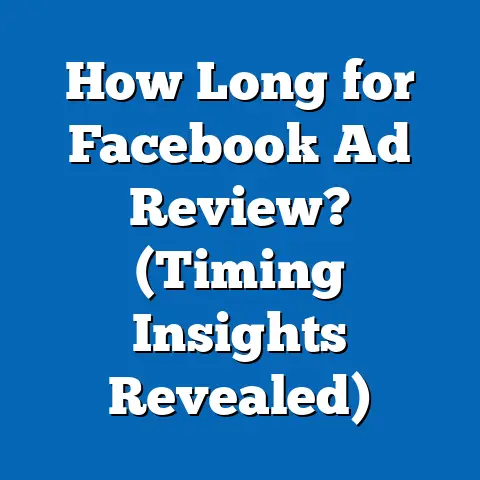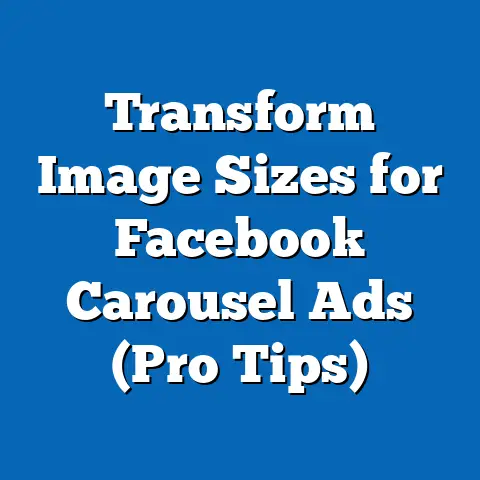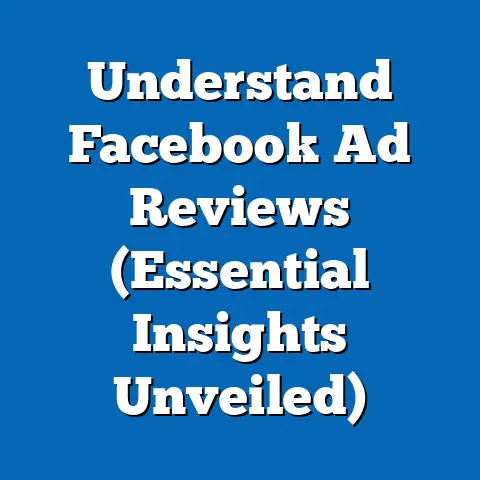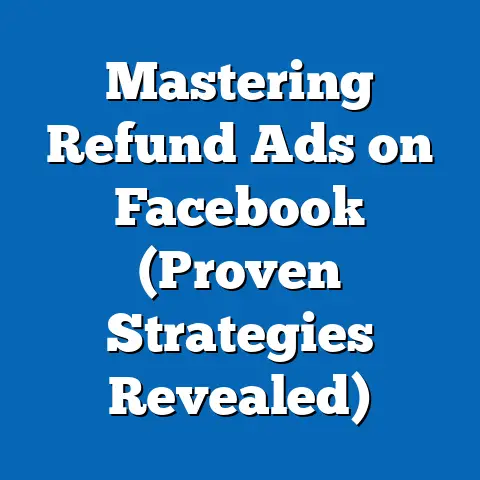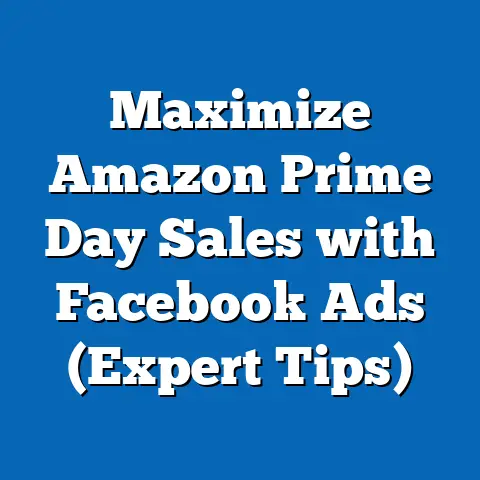Unlock Facebook Ads: Boost Purchases Now (Proven Strategies)
Facebook advertising. It’s a beast, I know. But trust me, it’s a beast worth taming. In today’s digital marketplace, if you’re not leveraging the power of Facebook ads, you’re leaving money on the table. With billions of active users and incredibly granular targeting options, Facebook offers an unparalleled opportunity to connect with potential customers and drive sales. But simply throwing money at ads isn’t enough. To truly succeed, you need a strategic approach tailored to the specific needs of your business and the unique demands of your target audience. And that’s what I’m here to help you with.
I’ve been running Facebook ads for years, seen the highs and the lows, and learned a thing or two along the way. I’ve managed campaigns for everything from local restaurants to national e-commerce brands, and I’ve consistently seen the power of a well-executed Facebook ad strategy.
The key, I’ve found, lies in understanding what I call “room-specific needs.” Think of it this way: a college student furnishing their dorm room has vastly different needs and priorities than a family renovating their kitchen. Advertising the same product with the same message to both groups simply won’t work.
1. Understanding Room-Specific Needs
So, what exactly do I mean by “room-specific needs”? It’s simple: recognizing that different products or services cater to distinct market segments with unique requirements, preferences, and pain points. It’s about understanding the context in which your product will be used and tailoring your advertising message accordingly.
Think about it:
- Home Decor: Someone shopping for living room furniture is likely concerned with aesthetics, comfort, and durability. Their pain points might include finding pieces that match their existing decor, staying within a budget, and ensuring the furniture is family-friendly.
- Fitness Products: An individual looking for home gym equipment might be focused on functionality, space-saving design, and achieving specific fitness goals. Their pain points could involve limited space, lack of motivation, and finding equipment that fits their skill level.
- Tech Gadgets: Someone interested in the latest smartphones or smart home devices might prioritize features, performance, and compatibility with their existing ecosystem. Their pain points could include staying up-to-date with the latest technology, understanding technical specifications, and finding products that offer the best value for money.
- Baby Products: Parents equipping a nursery will be primarily concerned with safety, comfort, and developmental benefits. Their pain points include ensuring products are non-toxic, easy to clean, and suitable for their child’s age and developmental stage.
The key to understanding these needs is to put yourself in your customer’s shoes. Imagine their daily life, their challenges, and their aspirations. What are they searching for? What problems are they trying to solve? What emotions are driving their purchasing decisions?
Why is this so important? Because when you truly understand your audience’s needs, you can craft ad content that speaks directly to them. You can highlight the specific features and benefits that matter most, address their pain points, and position your product as the perfect solution.
How to identify room-specific needs:
- Customer Feedback: This is gold! Pay close attention to customer reviews, surveys, and social media comments. What are people saying about your product? What problems are they encountering? What do they love?
- Market Research: Conduct thorough market research to understand the demographics, psychographics, and buying behaviors of your target audience. Tools like Facebook Audience Insights, Google Trends, and industry reports can provide valuable data.
- Competitor Analysis: Analyze your competitors’ advertising strategies. What messages are they using? What audiences are they targeting? What seems to be working for them? This can give you insights into what resonates with your target market.
- Talk to Your Sales Team: Your sales team is on the front lines, interacting with customers every day. They can provide valuable insights into customer needs, pain points, and purchasing motivations.
- Run Surveys and Polls: Directly ask your target audience about their needs and preferences. Tools like SurveyMonkey and Typeform make it easy to create and distribute surveys.
- Engage on Social Media: Actively participate in relevant online communities and forums. Listen to conversations, ask questions, and gather insights from potential customers.
My experience: I once worked with a company selling ergonomic office chairs. Initially, their Facebook ads focused on general features like “comfort” and “support.” However, after conducting customer interviews, we discovered that many customers were specifically concerned about back pain and posture. We then revamped the ad copy to highlight the chair’s lumbar support and posture-correcting features, which led to a significant increase in click-through rates and conversions. This experience taught me the power of listening to your customers and tailoring your message to their specific needs.
Key Takeaway: Understanding room-specific needs is the foundation of any successful Facebook ad campaign. Take the time to research your target audience, identify their pain points, and craft ad content that resonates with their unique requirements.
Next Step: Conduct thorough research on your target audience to identify their room-specific needs. Use the methods outlined above to gather insights and inform your advertising strategy.
2. Crafting Compelling Ad Content
Once you understand your target audience’s room-specific needs, the next step is to craft compelling ad content that captures their attention and persuades them to take action. This involves creating visually appealing ad creatives and writing clear, persuasive copy.
The Power of Visuals:
In the visually-driven world of Facebook, your ad’s creative is often the first thing people see. High-quality images and videos are essential for showcasing your product in its intended environment and capturing the attention of potential customers.
- Show, Don’t Just Tell: Instead of simply describing your product, show it in action. For example, if you’re selling a kitchen appliance, feature it in a video demonstrating its capabilities and ease of use.
- Highlight Key Features: Use visuals to showcase the product’s key features and benefits. For example, if you’re selling a mattress, highlight its memory foam construction and pressure-relieving properties.
- Create a Mood: Use visuals to create a specific mood or atmosphere. For example, if you’re selling outdoor furniture, feature it in a setting that evokes relaxation and enjoyment.
- Use Professional Photography: Invest in professional photography and videography to ensure your ad creatives are high-quality and visually appealing.
- Adhere to Facebook’s Specifications: Pay attention to Facebook’s ad image and video specifications to ensure your creatives are optimized for the platform.
The Art of Persuasive Copy:
While visuals are important, your ad copy plays a crucial role in conveying your message and persuading potential customers to take action.
- Headline That Grabs Attention: Your headline is the first thing people read, so make it count. Use strong verbs, compelling adjectives, and a clear value proposition to grab their attention.
- Address Pain Points: Directly address the pain points of your target audience. Show them that you understand their challenges and that your product offers a solution.
- Highlight Benefits, Not Just Features: Focus on the benefits of your product, not just its features. Explain how it will improve their lives, solve their problems, or fulfill their desires.
- Use a Clear Call to Action: Tell people exactly what you want them to do. Use strong verbs like “Shop Now,” “Learn More,” or “Get Started.”
- Keep it Concise: People have short attention spans, so keep your ad copy concise and to the point. Focus on the most important information and avoid unnecessary jargon.
- Use Emotion: Connect with your audience on an emotional level. Use language that evokes feelings of excitement, happiness, or relief.
- Test Different Copy Variations: Use A/B testing to experiment with different ad copy variations and see what resonates best with your target audience.
Examples of Successful Ad Copy:
- For a Home Decor Brand: “Transform Your Living Room into a Cozy Oasis. Shop our collection of stylish and comfortable furniture today!”
- For a Fitness Product: “Achieve Your Fitness Goals from the Comfort of Your Home. Our home gym equipment is designed to help you get in shape without the hassle of going to the gym.”
- For a Tech Gadget: “Stay Connected and Productive with the Latest Smartphone. Experience lightning-fast performance and stunning visuals.”
- For a Baby Product: “Give Your Baby the Best Start in Life. Our non-toxic and eco-friendly nursery products are designed for safety and comfort.”
My Experience: I recall working with a client who sold high-end bedding. Their initial ads featured generic images of their products with copy that simply stated “luxury bedding.” While the products were beautiful, the ads weren’t performing well. After conducting some research, we discovered that their target audience was primarily concerned with getting a good night’s sleep and reducing stress. We then revamped the ad creatives to feature images of serene bedrooms with copy that emphasized the bedding’s comfort, breathability, and ability to promote relaxation. This resulted in a significant increase in click-through rates and conversions, demonstrating the power of aligning your ad content with your audience’s emotional needs.
Key Takeaway: Compelling ad content is the key to capturing the attention of your target audience and persuading them to take action. Use high-quality visuals, persuasive copy, and a clear call to action to create ads that resonate with your audience’s room-specific needs.
Next Step: Review your existing Facebook ads and identify areas for improvement. Experiment with different ad creatives and copy variations to see what performs best.
3. Targeting the Right Audience
You can have the most beautiful ad creative and the most persuasive copy in the world, but if you’re showing it to the wrong people, it’s all for naught. That’s why targeting the right audience is absolutely crucial for Facebook ad success.
Facebook offers a wealth of targeting options, allowing you to reach specific groups of people based on their demographics, interests, behaviors, and connections.
Demographic Targeting:
- Location: Target people based on their location, from broad regions to specific zip codes.
- Age: Target people based on their age range.
- Gender: Target people based on their gender.
- Language: Target people based on the languages they speak.
- Education: Target people based on their education level.
- Relationship Status: Target people based on their relationship status.
- Job Title: Target people based on their job title.
Interest Targeting:
- Interests: Target people based on their interests, such as hobbies, passions, and activities.
- Behaviors: Target people based on their behaviors, such as purchase history, travel habits, and online activities.
Connection Targeting:
- Custom Audiences: Create custom audiences based on your existing customer data, such as email lists, website visitors, and app users.
- Lookalike Audiences: Create lookalike audiences based on your custom audiences, targeting people who share similar characteristics and behaviors.
Creating Custom Audiences:
Custom audiences are one of the most powerful targeting tools available on Facebook. They allow you to reach people who have already interacted with your business, such as website visitors, email subscribers, and app users.
- Website Visitors: Target people who have visited specific pages on your website. This is a great way to retarget people who have shown interest in your products or services.
- Email Lists: Upload your email list to Facebook and target people who are on your list. This is a great way to reach existing customers and subscribers.
- App Users: Target people who have downloaded and used your mobile app.
Creating Lookalike Audiences:
Lookalike audiences allow you to reach new people who are similar to your existing customers. Facebook analyzes the characteristics and behaviors of your custom audience and identifies other users who share those traits.
- Source Audience: Choose a custom audience as your source audience.
- Audience Size: Select the size of your lookalike audience. A smaller audience will be more targeted, while a larger audience will have a broader reach.
- Location: Choose the location of your lookalike audience.
A/B Testing Audience Segments:
It’s important to A/B test different audience segments to determine which ones are most responsive to your ads. Create multiple ad sets, each targeting a different audience segment, and track their performance.
- Split Test Different Interests: Experiment with different interest categories to see which ones generate the best results.
- Test Different Age Ranges: Try targeting different age ranges to see which one is most receptive to your ads.
- Compare Custom Audiences to Lookalike Audiences: See how custom audiences perform compared to lookalike audiences.
My Experience: I worked with a client selling organic baby clothing. Initially, their Facebook ads targeted a broad audience of parents with young children. However, we weren’t seeing the results we wanted. After analyzing our data, we discovered that our most valuable customers were those who had previously purchased organic products or expressed an interest in sustainable living. We then created a custom audience of website visitors who had viewed our organic clothing collection and a lookalike audience based on this custom audience. By targeting these more specific audience segments, we saw a significant increase in click-through rates, conversions, and overall ROI. This experience highlighted the importance of going beyond broad demographic targeting and focusing on the specific interests and behaviors of your ideal customers.
Key Takeaway: Targeting the right audience is essential for Facebook ad success. Utilize Facebook’s diverse targeting options to reach specific groups of people based on their demographics, interests, behaviors, and connections. A/B test different audience segments to optimize your targeting strategy and maximize your ROI.
Next Step: Review your existing Facebook ad targeting settings and identify areas for improvement. Experiment with different audience segments and A/B test your ads to see what performs best.
4. Utilizing Facebook Pixel for Enhanced Tracking
The Facebook Pixel is a powerful tool that allows you to track user behavior on your website and measure the effectiveness of your Facebook ad campaigns. It’s a small snippet of code that you place on your website, and it allows you to track events like page views, add-to-carts, and purchases.
How the Facebook Pixel Works:
When someone clicks on your Facebook ad and visits your website, the Facebook Pixel fires and records their activity. This data is then used to:
- Track Conversions: Measure the number of purchases, leads, or other desired actions that result from your Facebook ads.
- Optimize Ad Campaigns: Improve the performance of your ad campaigns by targeting people who are more likely to convert.
- Retarget Website Visitors: Show ads to people who have previously visited your website.
- Create Lookalike Audiences: Create lookalike audiences based on people who have converted on your website.
Setting Up the Facebook Pixel:
- Create a Pixel: In Facebook Ads Manager, navigate to the “Pixels” section and click “Create Pixel.”
- Install the Pixel Code: Copy the Pixel code and paste it into the
<head>section of your website’s code. - Set Up Events: Configure the Pixel to track specific events, such as page views, add-to-carts, and purchases. You can do this using standard events or custom events.
Retargeting Ads with the Facebook Pixel:
Retargeting ads are a powerful way to re-engage people who have previously visited your website but haven’t completed a purchase.
- Target Specific Pages: Show ads to people who have visited specific product pages or category pages on your website.
- Use Dynamic Product Ads: Show ads that feature the specific products that people have viewed on your website.
- Offer Incentives: Offer discounts or free shipping to encourage people to complete their purchase.
Case Studies and Examples:
- E-commerce Store: An e-commerce store used the Facebook Pixel to track purchases and retarget website visitors who had added items to their cart but hadn’t completed the checkout process. By showing these users targeted ads with a discount code, they were able to recover a significant portion of abandoned carts and increase sales.
- Lead Generation Business: A lead generation business used the Facebook Pixel to track lead submissions and optimize their ad campaigns. By targeting people who were more likely to submit a lead form, they were able to increase their lead generation rate and reduce their cost per lead.
My Experience: I worked with a client selling handmade jewelry. They were running Facebook ads, but they weren’t seeing the results they wanted. After installing the Facebook Pixel and setting up conversion tracking, we discovered that many people were visiting their website but not completing a purchase. We then created a retargeting campaign that showed ads to these website visitors, featuring the specific jewelry pieces they had viewed. This resulted in a significant increase in sales and a much higher return on ad spend. This experience demonstrated the power of the Facebook Pixel for tracking user behavior and optimizing ad campaigns.
Key Takeaway: The Facebook Pixel is an essential tool for tracking user behavior, measuring conversions, and optimizing your Facebook ad campaigns. Install the Pixel on your website, set up events to track specific actions, and use retargeting ads to re-engage website visitors and increase sales.
Next Step: Install the Facebook Pixel on your website and set up events to track specific actions. Create retargeting campaigns to re-engage website visitors and increase sales.
5. Optimizing Ad Campaigns for Maximum ROI
Once you’ve created your Facebook ad campaigns and installed the Facebook Pixel, the next step is to optimize your campaigns for maximum ROI. This involves setting clear goals, tracking your results, and making adjustments to your campaigns based on your data.
Setting Clear Goals:
Before you start running your ad campaigns, it’s important to set clear goals. What do you want to achieve with your ads? Do you want to increase sales? Generate leads? Drive traffic to your website?
- Specific Goals: Set specific, measurable, achievable, relevant, and time-bound (SMART) goals.
- Focus on Purchase Metrics: Focus on metrics that are directly related to purchases, such as conversion rate, cost per purchase, and return on ad spend.
Conversion Tracking:
Conversion tracking is essential for measuring the effectiveness of your ad spend. By tracking conversions, you can see how many people are taking the desired action after clicking on your ad.
- Use the Facebook Pixel: The Facebook Pixel allows you to track conversions on your website.
- Track Offline Conversions: You can also track offline conversions, such as phone calls and in-store purchases.
Strategies for Optimizing Ad Performance:
- Adjust Budgets: Adjust your budgets based on the performance of your ad campaigns. Allocate more budget to campaigns that are performing well and less budget to campaigns that are not.
- Revise Targeting Options: Revise your targeting options based on the performance of your ad sets. Experiment with different demographics, interests, and behaviors to see what works best.
- Refresh Ad Creatives Regularly: Refresh your ad creatives regularly to keep your ads fresh and engaging. Use new images, videos, and copy to capture the attention of your target audience.
- A/B Test Your Ads: A/B test different ad variations to see which ones perform best. Experiment with different headlines, images, copy, and calls to action.
Utilizing Facebook’s Analytics Tools:
Facebook offers a variety of analytics tools that can help you analyze your campaign performance and make data-driven decisions.
- Facebook Ads Manager: Facebook Ads Manager provides a comprehensive overview of your ad campaign performance, including metrics like impressions, clicks, conversions, and cost per conversion.
- Facebook Analytics: Facebook Analytics allows you to track user behavior across your website, app, and Facebook Page. This can help you understand how people are interacting with your business and identify areas for improvement.
My Experience: I worked with a client selling online courses. Initially, they were running Facebook ads, but they weren’t tracking their results effectively. After setting up conversion tracking and analyzing their data, we discovered that their cost per purchase was too high. We then started A/B testing different ad variations, targeting options, and landing pages. After several weeks of testing, we were able to significantly reduce their cost per purchase and increase their overall ROI. This experience highlighted the importance of tracking your results and making data-driven decisions to optimize your ad campaigns.
Key Takeaway: Optimizing your ad campaigns is essential for maximizing your ROI. Set clear goals, track your results, and make adjustments to your campaigns based on your data. Utilize Facebook’s analytics tools to analyze your campaign performance and make data-driven decisions.
Next Step: Review your existing Facebook ad campaigns and identify areas for improvement. Set clear goals, track your results, and make adjustments to your campaigns based on your data.
6. Leveraging Seasonal Trends and Promotions
One of the most effective ways to boost sales through Facebook ads is to capitalize on seasonal trends and promotions. People are often more receptive to advertising during certain times of the year, such as holidays, back-to-school season, and other special events.
Capitalizing on Seasonal Trends:
- Identify Relevant Trends: Identify seasonal trends that are relevant to your products or services. For example, if you’re selling home decor, you might focus on holiday decorations during the Christmas season or outdoor furniture during the summer months.
- Create Themed Ad Creatives: Create ad creatives that are themed around the seasonal trend. Use images, videos, and copy that are relevant to the season.
- Target Specific Dates: Target your ads to run during specific dates that are relevant to the seasonal trend. For example, you might run ads leading up to Black Friday or Cyber Monday.
Creating Time-Sensitive Promotions:
Time-sensitive promotions can be a great way to encourage immediate purchases. By creating a sense of urgency and scarcity, you can motivate people to take action.
- Offer Limited-Time Discounts: Offer discounts that are only available for a limited time.
- Run Flash Sales: Run flash sales that are only available for a few hours or days.
- Offer Free Shipping: Offer free shipping for a limited time.
- Use Urgency and Scarcity in Ad Copy: Use language that creates a sense of urgency and scarcity, such as “Limited Time Offer” or “While Supplies Last.”
Examples of Successful Seasonal Promotions:
- Back-to-School Sales: A clothing retailer ran a back-to-school sale that offered discounts on school uniforms and backpacks. They created Facebook ads that featured images of students wearing their clothes and carrying their backpacks. The ads were targeted to parents with school-aged children.
- Holiday Decorations: A home decor store ran a holiday decorations sale that offered discounts on Christmas trees, ornaments, and other holiday decorations. They created Facebook ads that featured images of festive homes decorated with their products. The ads were targeted to people who had expressed an interest in home decor and holiday celebrations.
My Experience: I worked with a client selling summer sports equipment. We knew that the demand for swimming gear, beach umbrellas, and outdoor games spikes during the summer. We launched a Facebook ad campaign with creatives showcasing people enjoying their products on sunny beaches. We used copy that highlighted the fun and excitement of summer and offered limited-time discounts on selected items. The campaign resulted in a significant increase in sales, proving the effectiveness of leveraging seasonal trends and promotions.
Key Takeaway: Leveraging seasonal trends and promotions can be a powerful way to boost sales through Facebook ads. Identify relevant trends, create themed ad creatives, and offer time-sensitive promotions to encourage immediate purchases.
Next Step: Plan your Facebook ad campaigns around upcoming seasonal trends and promotions. Create themed ad creatives and offer time-sensitive discounts to encourage immediate purchases.
Conclusion:
Facebook advertising, when done right, is a powerful tool to boost your business. We have covered a lot today, I know, but the most important thing is to start. Remember that understanding your audience, crafting compelling content, and constant optimization are the keys to success. By understanding room-specific needs and implementing the proven strategies outlined in this article, you can unlock the full potential of your Facebook advertising efforts and drive significant growth for your business.
Call to Action:
Ready to take your Facebook advertising to the next level? Start crafting your own targeted Facebook ad campaigns today, applying the strategies outlined in this article to maximize your advertising effectiveness and drive sales. Don’t wait, start seeing results now!

